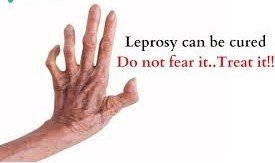Leprosy is a chronic disease caused by Mycobacterium leprae. It affects the skin, peripheral nerves, upper respiratory tract mucosa, and eyes. It is curable and early treatment can prevent disability.
One of the oldest chronic diseases, leprosy is caused by Mycobacterium leprae. The condition affects skin, peripheral nerves, upper respiratory tract mucosa, and eyes. Early treatment can avoid disability from leprosy.
Dr. Rashmi Aderao, MD Dermatology Consultant at Ruby Hall Clinic, says the body’s response to infection generates extreme inflammation and nerve damage, resulting in peripheral neuropathy. Thus, the affected person gradually loses sensation in these locations, causing erosion, ulceration, bacterial superinfection, loss of fingers and toes, nose structure damage, and blindness.
Leprosy patients were mistreated for fear of spreading the disease. They lived in the most rundown villages, frequently surrounded by fences and barbed wires, with no protection from nature, little food or water, and no medical care.
The WHO India country office supports the National Leprosy Eradication Programme. WHO supplies leprosy multi-drug combination (MDT) medications continuously. WHO supports planning, capacity building, community education, monitoring and supervision, campaign preparation, and service quality monitoring.
Active case detection works to identify suspected patients in the community for early diagnosis and treatment. Every year, the SPARSH Campaign holds village-level awareness initiatives to educate communities, reduce stigma and discrimination, and discover infected persons and connect them to health treatment.
It is vital to change the stigma of leprosy and urge people to seek treatment for worrisome skin patches. Information campaigns could raise the community’s suspicion index and encourage informed treatment of worrisome skin lesions. Leprosy as a curable disease and handicap management as home-based care will progressively gain popularity.
Early detection and treatment are crucial to India’s 2027 Leprosy-Free Future. Through community engagement and annual awareness programs, early diagnosis and medical intervention reduce illness progression and disability. Early treatment reduces transmission and social stigma, helping affected persons gain community acceptance.
Treatment for Leprosy
Different antibiotics destroy germs in leprosy. In multidrug therapy, two or three antibiotics are given. If you suffer any of these while on treatment, see a dermatologist:
Nerve injury can cause numbness and loss of sensation.
If existing patches swell and hurt.Thus, early diagnosis and treatment prevent stigma and discrimination. Leprosy patients can contribute to society with therapy.
Conclusion
A chronic disease caused by Mycobacterium leprae, leprosy affects the skin, peripheral nerves, upper respiratory tract mucosa, and eyes. Curable and early treatment prevents impairment. World Health Organization supports India’s National Leprosy Eradication Programme, assuring multi-drug combination treatment drug supply. Active case identification and awareness initiatives identify suspected cases and encourage treatment. Early detection and treatment are essential for India’s 2027 Leprosy-Free Future.




